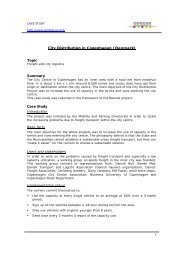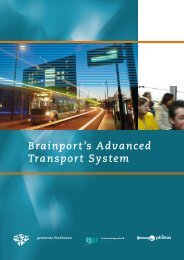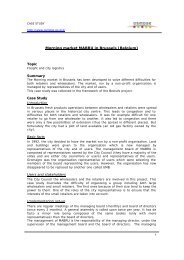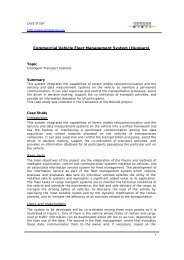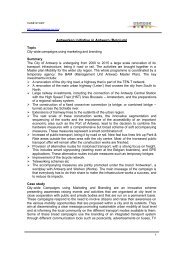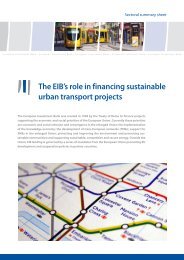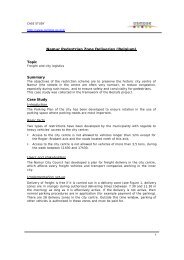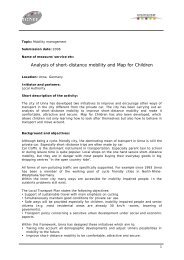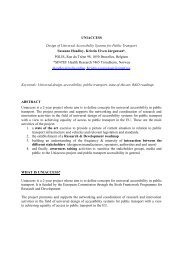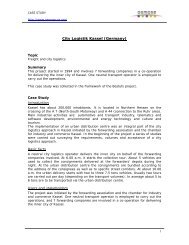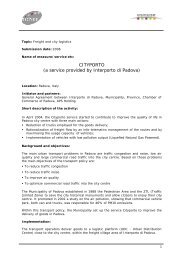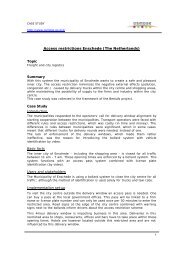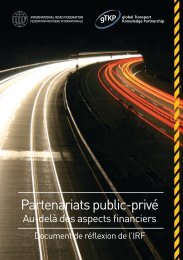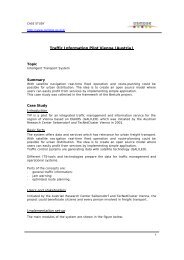Successful transport decision-making - Osmose
Successful transport decision-making - Osmose
Successful transport decision-making - Osmose
You also want an ePaper? Increase the reach of your titles
YUMPU automatically turns print PDFs into web optimized ePapers that Google loves.
Vol 1 - Table of Contents <br />
Next<br />
Exhibition<br />
An exhibition is an informal setting in which people can obtain information about a project. It has no set, formal agenda. Unlike a<br />
meeting, no formal discussions and presentations take place, and there are no audience seats. Instead, people gain information<br />
informally from exhibits and staff and are encouraged to give their opinions, comments, and preferences to staff either orally or in<br />
writing. Often exhibitions are used as part of a broader engagement strategy. In particular, they are useful for policies, plans or route<br />
options, as they enable visual material to be displayed, explained and discussion generated. Exhibitions provide an informal, casual,<br />
and friendly ambience. People drop by at their convenience, obtain the information that interests them, and stay as long as they wish.<br />
Informality encourages participants who are intimidated by formal meetings to attend and make their contribution; often the quality<br />
of responses is higher. The short time required for engagement attracts people who do not want to sit through long public meetings.<br />
Information centre<br />
An information centre is a place within a neighbourhood or community where people can obtain information on an on-going basis. An<br />
easy-to-find location in a local area makes it convenient and easy for people to get information about a project and to express their<br />
concerns and issues. An information centre offers informal, continuing contact with the community. It can have other names: field office,<br />
site office, or drop-in centre. An information centre typically has the following characteristics: It is visible to the community - an office,<br />
storefront, etc. in any visible, accessible, and convenient location within a project area or corridor; It can be mobile, using a van or<br />
trailer, to maximise contact with various stakeholders; It is open during specific, regular hours, not just occasionally or sporadically; It<br />
is usually in existence for a designated period of time, such as during the planning or construction phase of a project; and it is usually<br />
staffed by planning, project, and/or liaison personnel, knowledgeable about the area and the issues.<br />
Information session and briefing<br />
Information sessions/briefing are being considered as a major method for engaging community and stakeholder groups, especially<br />
those that wouldn't necessarily participate. These meetings would usually be requested by the project team to get specific community<br />
groups involved or can be requested by a community group to discuss certain issues of a project relevant to them. They usually<br />
involve exchanging information where the project team can learn more about the issues and local considerations, and the<br />
stakeholders can learn more about the project objectives, possible proposals and process.<br />
Public meeting<br />
Public meetings are generally considered as formal meetings arranged by the project team, the public or by an external stakeholder<br />
to discuss a certain aspect of a project. A public meeting would sometimes be called to discuss a contentious issue or technical aspect<br />
regarding a <strong>transport</strong> related project. Public meetings are usually a good way of explaining issues to the public and stakeholders and<br />
could be a valuable method of obtaining support from influential members of the public.<br />
Topical events<br />
An interesting and fun form of engaging with stakeholders is to set up an information stand, exhibition or information caravan at a local<br />
event. These local events could include fetes, band days, market days and road shows, and would usually involve a member of the<br />
project team booking a 'stall or piece of land' at such an event. The main focus of this type of event would be to encourage stakeholders<br />
to read the information, have discussions with a facilitator from the project team, and get involved in the project, by providing feedback<br />
on the project.<br />
When to use these tools<br />
These tools are particularly useful in bringing a project to<br />
the community, and <strong>making</strong> local people aware of the<br />
issues and options. If held in strategic locations, they can<br />
raise awareness, and create a presence in the area.<br />
How to avoid or overcome<br />
potential problems<br />
The community will often feel that <strong>transport</strong> projects are<br />
being imposed on them by people who are remote and do<br />
not understand their area, so holding an exhibition or<br />
opening an information centre is a good way of<br />
connecting with local people:<br />
<br />
<br />
<br />
<br />
<br />
Carefully choose the location for these events: they<br />
must be accessible, and neutral. Selecting the wrong<br />
location will create barriers before the community has<br />
even had the chance to see the proposals.<br />
Events in public offices or the developer’s offices will<br />
be perceived to be biased from the outset. Most<br />
people feel uneasy entering a strange place, so<br />
familiarity with the venue will help to make people feel<br />
at ease.<br />
If an exhibition is held in only one location, is only<br />
open for a limited time, contains inadequate or poorly<br />
displayed information, and is not properly staffed to<br />
ensure the community can engage in a proper<br />
dialogue, then this will create rather than overcome<br />
barriers.<br />
The staff at either an exhibition or information centre<br />
should have adequate knowledge of the project. But<br />
professional expertise is sometimes not enough and,<br />
to avoid creating unnecessary barriers, staff should<br />
be trained in talking and listening to people, and in<br />
how to deal with difficult situations.<br />
Exhibitions or information centres could provide a<br />
focus for counter events; objectors may try and hijack<br />
the exhibition to put over a counter view. This<br />
possibility should be planned for, and in some cases<br />
diffused, by inviting objectors to put up their own<br />
material alongside the official exhibition.<br />
75



